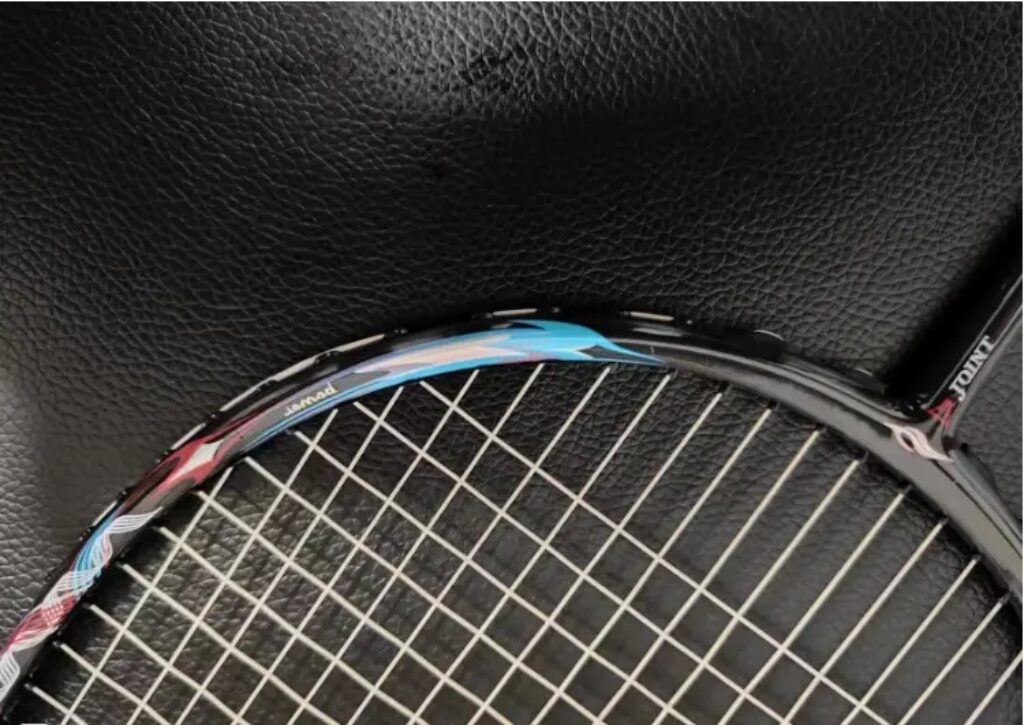A friend once mentioned that Pollen holds over 40 patented frame designs, showcasing the company’s strong research and development background. This gives them a significant edge over many domestic brands. However, in terms of high-end products, the standout models currently are the J20 aerodynamic frame, the 1982 box frame, the 2013 eight-sided aerodynamic frame, and the Infiniti small frame. These successful models have survived the market’s competitive selection process and are widely recognized, but I’ve grown tired of them.
Recently, Pollen has introduced some other notable frame designs, but I felt a bit uneasy upon hearing the name of this new racket. Such a blatant approach seems like a red flag, and it shouldn’t be overlooked. However, according to relevant sources, this frame is indeed newly developed. Given the skepticism surrounding Pollen’s promotional tactics, I hope the brand takes care to avoid potential issues.

Parameters: 4UG5, with a base, total weight 90.91g, balance point 297mm, 6.5mm shaft, made from 46T material, 222mm in length, with medium to high stiffness. The aerodynamic frame has a 72-hole string bed, 9-3 point string grooves, warranty of 30 pounds, strung at 25-27 lbs with VBS66N.
Returning to this new product, the color scheme follows Pollen’s “classic” style, featuring a glossy black finish with high-gloss stickers, making the frame look very sleek. The red and blue stickers spiral around the wings in a double helix pattern, with a color-changing effect. I find this texture appealing, as it resonates with my background. The font with its changing effect reminds me of the FC red and white gaming console—does it evoke memories of the original Castlevania?
Honestly, the sensation while swinging the racket is quite familiar, with the whooshing sound during cuts through the air bringing back many memories.

During warm-ups, it showed a slight head-heavy feel, allowing for good leverage, and the 72-hole string bed provides a sufficiently large sweet spot, making it easy to adapt compared to other Pollen speed rackets. However, after hitting a few high clears, I noticed something—this new model has extremely high elasticity! This elasticity is clearly a result of Pollen’s latest integration of boron fiber in the ultra-thin shaft.
Indeed, as indicated in the promotional material, the racket features a small flat head design, which can explain the slight explosive feel when hitting the sweet spot. Given its intended role as an offensive racket, I feel the 4U weight might be a bit insufficient; I’d recommend a 3U version for those capable. Yet, even at 4U, the racket’s responsiveness due to its highly elastic shaft and frame provides a unique power. The quick and surprising shot response is commendable. I initially intended to challenge the recent trend of prioritizing elasticity in rackets, but after using this one, I found myself at a loss for words. It delivers a powerful and thrilling feedback for every focused shot, effectively addressing any doubts I had. However, if it were up to me, I would suggest shortening the shaft by 5mm without considering the difficulty of handling.

Its swing speed is indeed fast, especially during the pulling phase, showcasing a sharp performance without feeling hindered by the head-heavy balance. The stiff shaft ensures rapid response and crisp shots, with no delay during consecutive swings, and the quick recovery of the shaft instills confidence against faster opponents.
This frame design is typically prone to torsional instability, especially with Pollen pairing it with a 6.5mm shaft, which even leading brands hesitate to implement on flagship speed rackets. However, Pollen has gone “all out” this time—maintaining high overall rigidity ensures sufficient stability, and the shot directionality and stability reach an impressive level. Just be careful not to swing it at anyone…

That said, the high stiffness of the frame makes delicate net play more challenging, requiring precise control of power and angle; otherwise, shots can easily go too high. While the “lifting” motion still effectively suppresses height, getting used to the feel for angled shots takes longer. The racket produces a strong rebound sensation for backcourt lifts; the “wrap” feeling is somewhat lacking, but the “cut” response is quick, resulting in higher quality for slices and redirects compared to straight lifts.
Having used many Pollen rackets, including the Smash series box frame, the God of War series aerodynamic frame, the Bow and Sword series trapezoidal frame, the Princess series 72-hole hybrid frame, the Extreme Phoenix series ultra-thin frame, and the Little Cannon series 88-hole thin-wing frame, I can say that the 72-hole small flat head diamond aerodynamic frame follows a similar approach, making its originality debatable.

However, from a performance perspective, “Liang Jian” stands solid. In terms of swing speed, this new product likely surpasses all other rackets of the same specifications and balance point, which is remarkable. It clearly demonstrates that it is not merely a product of imitation and assembly; producing such performance requires substantial effort.
Before encountering this product, I shared the same doubts as many players: why release a similarly capable frame when Pollen already has a mature aerodynamic design? I suppose this “Liang Jian” is meant to stand out amidst controversy. What astonishes me is that it may well perform better than any other “Liang Jian” I’ve used…


Leave a Reply